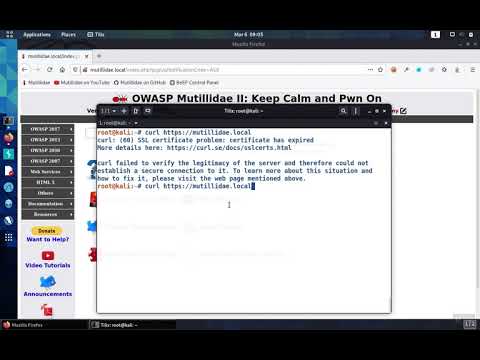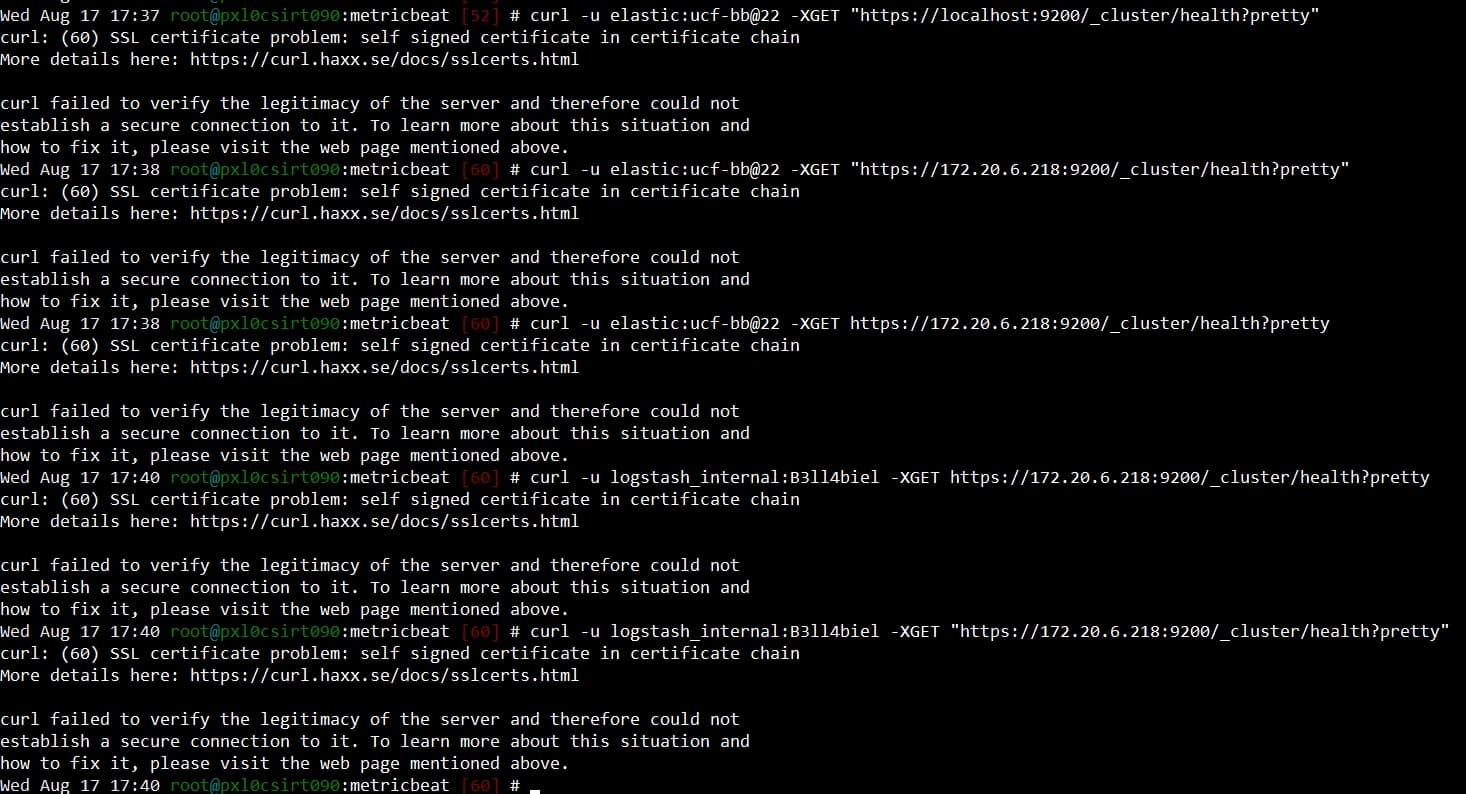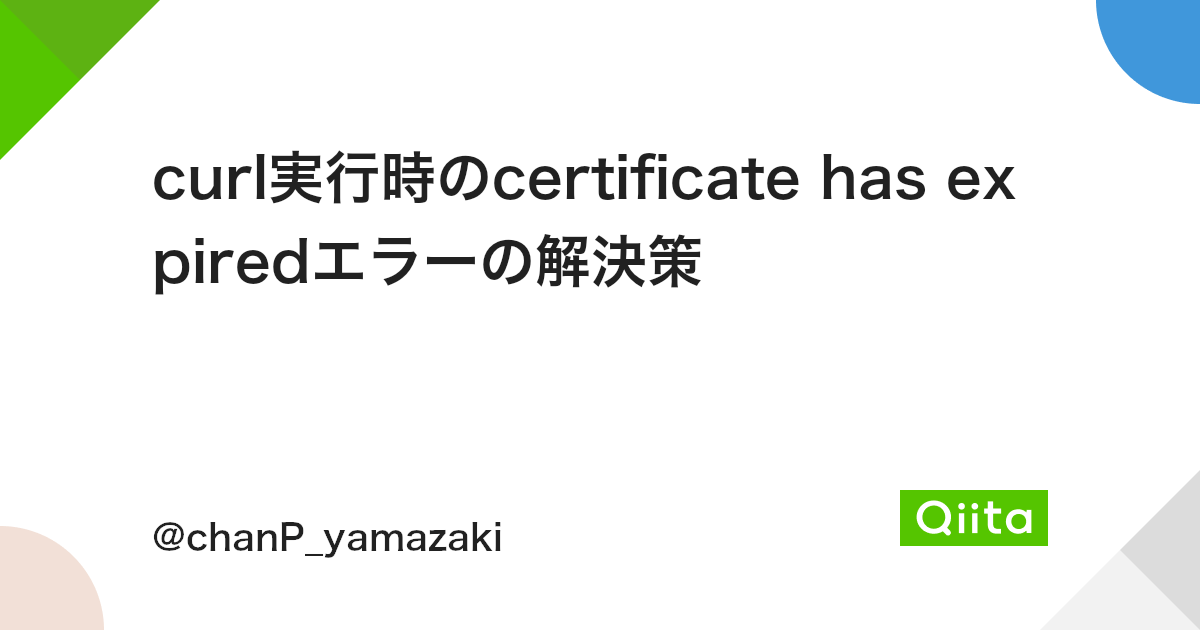Curl Failed To Verify The Legitimacy Of The Server
Understanding Curl’s SSL Certificate Verification
When making an HTTPS request, Curl verifies the server’s SSL certificate to ensure that the communication is secure and trusted. The SSL certificate contains information about the server, such as the domain name and the public key of the server. Curl checks the validity of the certificate, the cryptographic signature, and verifies if the certificate is issued by a trusted certificate authority (CA).
Root CA Certificates and their Importance in Curl’s Verification
To verify the legitimacy of the server’s certificate, Curl relies on a set of trusted root CA certificates. These certificates are embedded in Curl or available in the system’s certificate store. The root CA certificates are issued by globally recognized and trusted certificate authorities, such as VeriSign, DigiCert, and Let’s Encrypt. Curl uses these root CA certificates to verify the authenticity of the server’s certificate and establish a secure connection.
Verification Chain: Intermediate CA Certificates and Server Certificates
The SSL certificate verification process involves verifying the entire chain of certificates, starting from the server certificate and going up to the root CA certificate. Along with the server certificate, there may be one or more intermediate CA certificates. These intermediate CA certificates are used to create a chain of trust between the server’s certificate and the root CA certificate. Curl verifies the entire chain of certificates to ensure the legitimacy of the server.
Role of Certificate Authorities (CAs) in Curl’s Verification Process
Certificate Authorities (CAs) play a crucial role in the SSL certificate verification process. They issue SSL certificates to organizations and verify their authenticity. CAs are responsible for verifying the identity of the organization requesting the certificate and ensuring that they own the domain for which the certificate is being issued. Curl relies on the certificates issued by trusted CAs to establish secure connections.
Common Causes of Curl Failing to Verify Server Legitimacy
1. Outdated Curl Version: Using an outdated version of Curl may result in failure to verify the server’s legitimacy. It is recommended to update Curl to the latest version to ensure compatibility with the latest root CA certificates and security protocols.
2. Missing or Outdated CA Bundle: Curl relies on a CA bundle file that contains a collection of trusted root CA certificates. If the CA bundle is missing or outdated, Curl may fail to verify the server’s legitimacy. It is essential to update the CA bundle regularly.
3. Self-Signed or Invalid SSL Certificate: If the server’s certificate is self-signed or has expired, Curl may fail to verify its legitimacy. Self-signed certificates are not issued by trusted CAs and require manual verification or the addition of the certificate to the trusted CA list.
4. Network Connection Issues: Network connectivity issues or firewall restrictions can prevent Curl from accessing the necessary resources to verify the server’s legitimacy. It is recommended to check the network settings and ensure that the necessary ports and resources are accessible.
Fixing Curl’s Failure to Verify Server Legitimacy
5. Updating Curl to the Latest Version: Updating Curl to the latest version ensures compatibility with the latest root CA certificates and security protocols. Check the official Curl website or package manager for the latest version and follow the installation instructions.
6. Resolving Certification Authority (CA) Bundle Issues: If Curl fails to locate the CA bundle file or if it is outdated, it can result in failure to verify the server’s legitimacy. Download the latest CA bundle file from the Curl website or the system’s certificate store and configure Curl to use it by setting the appropriate environment variable or command-line option.
7. Troubleshooting Common SSL Verification Errors: SSL verification errors in Curl can provide valuable insights into the cause of the issue. Common errors include “unable to get local issuer certificate,” “server certificate verification failed,” and “SSL certificate verify result unable to get local issuer certificate 20 continuing anyway.” Search for the specific error message and follow the suggested troubleshooting steps.
8. Providing Custom CA Certificates to Curl: If the server’s certificate is issued by a custom or self-signed CA, you can provide the corresponding CA certificates to Curl. This can be done by setting the CURLOPT_CAINFO option in your Curl requests or by adding the CA certificates to the system’s trusted CA store.
FAQs
Q: What does the “unable to get local issuer certificate” error mean in Curl?
A: The “unable to get local issuer certificate” error usually occurs when Curl cannot find the issuer’s (CA’s) certificate in the local CA store or the specified CA bundle file. It indicates that Curl cannot verify the server’s certificate due to the missing CA certificate.
Q: How can I disable SSL certificate verification in Curl?
A: Disabling SSL certificate verification is not recommended as it can expose your communication to security risks. However, in some cases, such as testing or development environments, you may choose to disable verification. This can be done by adding the CURLOPT_SSL_VERIFYPEER option and setting it to `false` in your Curl requests. Remember to enable verification in production environments.
In conclusion, Curl’s failure to verify the legitimacy of the server’s SSL certificate can pose security risks. It is crucial to understand Curl’s SSL certificate verification process, the role of root CA certificates and intermediate CA certificates, and the importance of trusted certificate authorities. By updating Curl to the latest version, resolving CA bundle issues, troubleshooting SSL verification errors, and providing custom CA certificates when necessary, you can ensure secure and trusted connections with Curl.
Curl Error: Ssl Certificate Problem
Keywords searched by users: curl failed to verify the legitimacy of the server curl: (60) ssl certificate problem: unable to get local issuer certificate, SEC_E_UNTRUSTED_ROOT curl, Server certificate verification failed CAfile none CRLfile: none, Wsl curl ssl certificate problem, The revocation function was unable to check revocation for the certificate, PHP cURL SSL verify false, SSL certificate verify result unable to get local issuer certificate 20 continuing anyway, Curl insecure in PHP
Categories: Top 61 Curl Failed To Verify The Legitimacy Of The Server
See more here: nhanvietluanvan.com
Curl: (60) Ssl Certificate Problem: Unable To Get Local Issuer Certificate
What is the “ssl certificate problem: unable to get local issuer certificate” error?
When you encounter this error with curl, it means that curl is unable to verify the SSL certificate presented by the server you are trying to connect to. When establishing secure connections, curl checks the server’s SSL certificate against a list of trusted CA (Certificate Authority) certificates installed on your system. If the CA certificate used to sign the server’s certificate is not found in that list, the error message “ssl certificate problem: unable to get local issuer certificate” is displayed.
Causes of the “ssl certificate problem: unable to get local issuer certificate” error:
1. Outdated CA certificates: If the CA certificates installed on your system are not up to date or missing, curl will be unable to verify the server’s SSL certificate.
2. Misconfigured server: The server may have improperly configured its SSL certificate, including the certificate chain or intermediate certificates, leading to the “ssl certificate problem: unable to get local issuer certificate” error.
3. Proxy interference: When using a proxy server, it may modify the SSL certificate chain, making it unverifiable by curl.
4. Self-signed certificates: If the server is using a self-signed certificate instead of one issued by a trusted CA, curl will flag it as untrusted, resulting in this error.
Troubleshooting steps to fix the “ssl certificate problem: unable to get local issuer certificate” error:
1. Update CA certificates: Ensure that your system’s CA certificate store is up to date. You can update them manually or use your operating system’s package manager to install any updates available.
2. Specify the CA certificate: If you have the CA certificate in a separate file, you can provide its path to curl using the “–cacert” option. This instructs curl to use that specific CA certificate for verification.
3. Disable SSL verification: Although not recommended, you can temporarily bypass the SSL certificate check by using the “-k” or “–insecure” option with curl. This should only be used when testing or in controlled environments, as it leaves your data susceptible to potential security threats.
4. Verify the server’s SSL certificate: Inspect the server’s SSL certificate using tools like OpenSSL. Ensure that it includes the necessary intermediate certificates and that they are correctly chained. Contact the server administrator if there are any discrepancies.
5. Trust self-signed certificates: If you are connecting to a server with a self-signed certificate, you can add it to your system’s trusted CA certificates store. However, exercise caution and only add certificates from trusted sources.
6. Check proxy configuration: If you are using a proxy server, ensure it is not interfering with the SSL certificate verification process. Temporarily disable the proxy or try connecting without it to isolate the issue.
FAQs:
Q1. Why does curl show the “ssl certificate problem: unable to get local issuer certificate” error?
A1. Curl displays this error when it cannot verify the server’s SSL certificate against the list of trusted CA certificates installed on your system.
Q2. How can I update the CA certificates on my system?
A2. The process varies depending on your operating system. On Linux distributions, you can use the package manager to update the ca-certificates package. On Windows, you can manually download and install the updated CA certificates from the official Microsoft website.
Q3. Can I ignore the “ssl certificate problem: unable to get local issuer certificate” error?
A3. While it is possible to bypass the SSL certificate check using the “-k” or “–insecure” option, it is not recommended as it compromises the security of your connection. Only use it for testing or in controlled environments.
Q4. How can I obtain the missing CA certificate?
A4. If you are missing the CA certificate required to verify the server’s SSL certificate, you can contact the server administrator or the organization responsible for issuing the certificate.
Q5. Is there a way to specify a custom path for CA certificates?
A5. Yes, you can specify the path to a custom CA certificate file using the “–cacert” option with curl. This allows you to use a specific CA certificate for verification purposes.
In conclusion, the “ssl certificate problem: unable to get local issuer certificate” error in curl is a common connectivity issue faced by users. By understanding its causes and following the provided troubleshooting steps, you can successfully overcome this error and establish secure connections using curl. Remember to update your CA certificates regularly and exercise caution when dealing with self-signed or untrusted certificates.
Sec_E_Untrusted_Root Curl
Introduction:
When using the cURL library for data transfer over various protocols, encountering errors is not uncommon. One such error, SEC_E_UNTRUSTED_ROOT, often perplexes developers and system administrators alike. In this article, we will delve into the depths of SEC_E_UNTRUSTED_ROOT curl error, exploring its causes, potential solutions, and addressing common FAQs surrounding this topic.
Understanding the SEC_E_UNTRUSTED_ROOT Error:
The SEC_E_UNTRUSTED_ROOT error within cURL indicates that the server’s certificate chain cannot be verified up to a trusted root certificate authority (CA). This error serves as a security measure implemented to safeguard users against potential security threats. When a certificate authority’s trust chain is broken or not recognized, cURL returns this error to prevent potential malicious attacks.
Causes of SEC_E_UNTRUSTED_ROOT Error:
1. Self-Signed Certificates: When a web server uses a self-signed certificate or a certificate issued by an internal CA, the client may not trust the chain of certificates, thus triggering the error.
2. Missing Intermediate Certificates: If the server certificate chain does not include all intermediate certificates required for the validation process, SEC_E_UNTRUSTED_ROOT may arise.
3. Expired or Revoked Certificate: If the server’s certificate has expired or been revoked, cURL will raise the SEC_E_UNTRUSTED_ROOT error.
4. Misconfigured Trust Stores: If the client’s trust store does not contain the root CA certificate that signed the server certificate, the error can be triggered.
Solutions to Resolve SEC_E_UNTRUSTED_ROOT Error:
1. Trusting Self-Signed Certificates: Use the cURL `–insecure` option to bypass certificate verification, but exercise caution as it weakens security measures.
2. Adding the Missing Intermediate Certificate Chain: If intermediate certificates are not provided in the server’s chain, manually obtain them from the certificate issuer and append them to the server certificate file.
3. Updating Outdated Certificates: Ensure that the server’s certificate is not expired or revoked. If it is, obtain and configure a valid certificate to resolve the error.
4. Verifying Trust Store Configuration: Confirm that the client’s trust store contains the correct root CA certificate used to sign the server certificate. Update the trust store if necessary.
FAQs about SEC_E_UNTRUSTED_ROOT Error in cURL:
Q1. Can I safely ignore the SEC_E_UNTRUSTED_ROOT error and still proceed with the request?
Ignoring this error can compromise the security of your system, leaving it vulnerable to various security attacks. However, in specific scenarios such as internal testing or accessing trusted resources without a valid certificate, you can choose to bypass the error using the `–insecure` option with cURL. But it is crucial to exercise caution and avoid such practices in production environments.
Q2. How can I obtain the intermediate certificates required to complete the server certificate chain?
The SSL Server Test (https://www.ssllabs.com/ssltest/) allows you to analyze a server’s SSL configuration and provides detailed information about the certificate chain. By examining the results, you can identify missing intermediate certificates and acquire them from the issuer.
Q3. Can I modify cURL’s SSL certificate verification process programmatically?
Yes, cURL provides various options to customize the SSL certificate verification process. For instance, the CURLOPT_SSL_VERIFYPEER option allows you to enable or disable the verification process entirely, while CURLOPT_CAPATH or CURLOPT_CAINFO point to a custom certificate authority file or directory.
Q4. Why do I still encounter SEC_E_UNTRUSTED_ROOT error even after adding intermediate certificates?
In some cases, intermediate certificates may be successfully added, but the server’s configuration might not be updated to include them during the handshake process. This could result in the SEC_E_UNTRUSTED_ROOT error. Ensure that the server is configured correctly to serve the updated certificate chain.
Q5. Is it necessary to periodically update root CA certificates in the trust store?
Yes, regularly updating root CA certificates is recommended to maintain a secure and up-to-date trust chain. Failure to update may result in SEC_E_UNTRUSTED_ROOT errors when the older root certificate expires or is revoked.
Conclusion:
Addressing the SEC_E_UNTRUSTED_ROOT error in cURL requires a thorough understanding of its causes and possible solutions. By ensuring the server’s certificate chain, including intermediate certificates, is properly configured, developers can overcome this error and establish secure communication channels. However, it is important to strike a balance between security and convenience to avoid compromising data integrity and privacy. By remaining vigilant and following best practices, developers can mitigate the SEC_E_UNTRUSTED_ROOT error and ensure the confidentiality and security of their applications.
Images related to the topic curl failed to verify the legitimacy of the server

Found 38 images related to curl failed to verify the legitimacy of the server theme















Article link: curl failed to verify the legitimacy of the server.
Learn more about the topic curl failed to verify the legitimacy of the server.
- Fix “failed to verify the legitimacy of the server” error in cURL
- How to disable cURL SSL certificate verification – Stack Overflow
- cURL is showing certificate error when accessing HTTPS site
- curl failed to verify the legitimacy of the server and therefore …
- Ignore SSL Certificate Error with cURL – Linux Handbook
- Curl failed to verify server : r/unix – Reddit
- Error “certificate verify failed” returned from curl command
- Rest API, giving: (60) SSL certificate problem – Ivanti Community
- Curl: (60) SSL Certificate Problem – The freeCodeCamp Forum
- Validating Certificates Using cURL | Baeldung on Linux
See more: nhanvietluanvan.com/luat-hoc